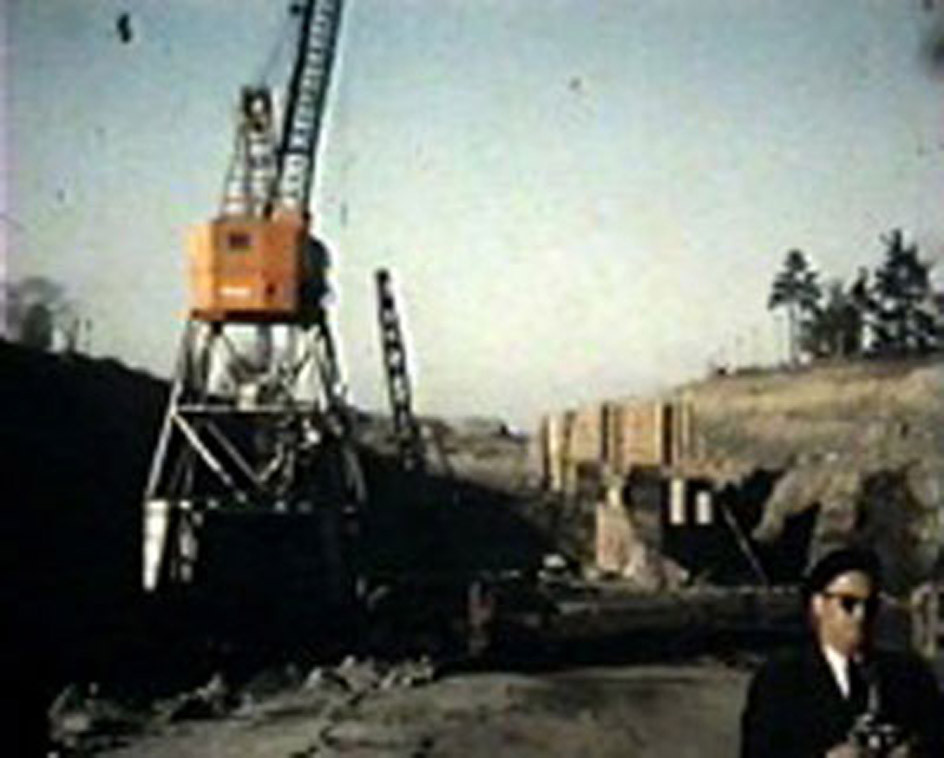


Smithfield (2000), 35mm, colour, no sound, 4 minutes (looped).
Smithfield consists of a four-minutes tracking shot where the camera moves around a wedge-shaped late-19th century 'corner' building situated opposite London's Smithfield Market. Smithfield is an unedited single take of a 400ft roll of 35mm colour film. The duration of the film and the precise progression of the track is predetermined by a simple exigency: the commercial manufacture of 35mm film. The building which the camera tracks around is glassed on both sides and Smithfield allows for a series of shifting glimpses through, across and inside the building's internal space. The film is shot at night and the only registered activity, apart from the movement of the camera, is that of a night cleaner who mops the floor, over and over again. Smithfield documents the almost invisible activity via the camera's two near-360 degree passes around the perimeter of the building, while at the same time registering the extent to which the mobile cinematic camera transforms the traditional figure-ground relationship of pictorial representation.If that relationship, and its undoing, has been one of the central preoccupations of modern art, then film, with its deceptively pre-modern image form, establishes a particular manipulation and falsification of dimension as its very own invention.
Mark Lewis, May 2000
Visite du port, 16 mm, colour, no sound, 10 minutes.
This anonymous documentary, discovered in Montreal, was produced towards the end of the 1950s. The film retraces the visits of engineers to several construction sites in the city. Originally created in 16 mm, the film has been transferred to video and edited by Régine Gallard and Kristina Solomoukha. In the event of the Cinema and Urban Remains festival, the artists have decided to render visible this short account within the city of its realisation. Projected on to a window visible from the exterior, Visite du port allows for the creation of a subjective vision of a past event and the contemporary reality of the city.This is the first collaboration between Régine Gallard and Kristina Solomoukha, whose respective artistic processes have been strongly influenced by the act of geographical relocation. Reflections on the city, and an awareness of the relationship between artistic production and the context of its presentation, are considerations shared by both artists.
Mark Lewis
Lewis attended Harrow College of Art (London) and the Polytechnic of Central London. He started as a photographer and began making film-based installations in the mid‑1990s. He has had solo museum exhibitions at the UBC Fine Arts Museum,Vancouver, Vancouver Art Gallery, Hamburger Kunstverein, Musée d’art moderne (Luxembourg), BFI Southbank (London), and the National Museum of Contemporary Art (Bucharest, Romania). His work is in many collections including the National Gallery of Canada, Museum of Modern Art New York, Musée d’art contemporain de Montréal, and the Centre Pompidou (Paris).
Lewis was born in Hamilton, Ontario and now lives and works in London, England. In the 1980s, he studied with Victor Burgin and worked with Laura Mulvey which influenced his later approach to cinema and video. Mulvey and Lewis produced the documentary Disgraced Monuments in 1991. From 1989 to 1997 he lived in Vancouver becoming part of the burgeoning photoconceptualism scene of the Vancouver School. Much of his work focuses on the technology of film and the different genres which have been developed in over 100 years of film history. His films are often short, precise exercises on particular techniques.
He is co-editorial director of the publisher Afterall, which produces a journal of contemporary art and a series of books and readers. It is published in London, Antwerp and Seville.
Curator
Caroline Andrieux
